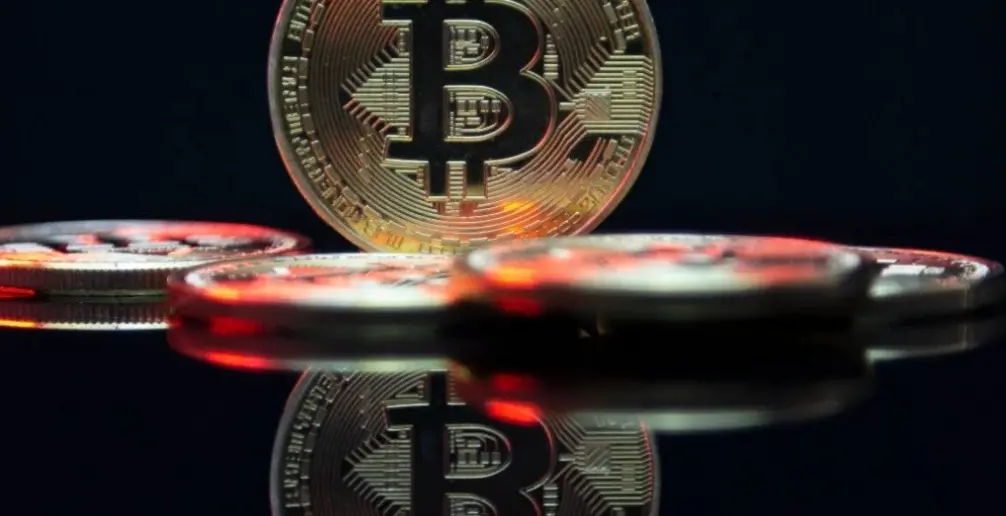5-day countdown! Understand the hidden Bitcoin "halving" code within the cycle
Written by: River
In 2024, the market is eagerly anticipating three major clear benefits this year—spot Bitcoin ETF, Bitcoin halving, and Federal Reserve interest rate cuts. The first has already materialized, pushing Bitcoin to break through $70,000, setting a new historical high.
Now, with the halving approaching, more than half of this year's three major benefits are about to be realized, which may impact the evolution of the new market. According to OKLink statistics, there are now less than 5 days remaining until the fourth Bitcoin halving, expected on April 20, 2024, when the block reward will decrease from 6.25 BTC to 3.125 BTC.
As one of the most important narratives in the crypto industry, "Bitcoin halving" has always been a significant stimulating event that the market holds great expectations for. As we face the end of a new halving cycle, what should we expect in 2024, and what new variables have emerged in the market?

What Impact Does Halving Have on the Crypto Market?
We can briefly understand the basic knowledge of Bitcoin halving: the mechanism design of Bitcoin makes the role of miners exceptionally important, serving as the cornerstone of the entire system's transaction operations, and currently, miners' income mainly comes from two parts—block rewards and transaction fees.
Initially, the block reward was 50 Bitcoins, with the rule that it halves every four years. It has already halved three times to 6.25 BTC, and in 5 days, it will be the fourth halving, after which there will be no block rewards for Bitcoin by 2140;
However, transaction fees will always exist, so in the future, miners' income will become very singular, relying solely on transaction fee rewards. This is why the crypto industry has always been one of the most cyclical industries.
From a historical perspective, each halving has been a grand event, especially the first Bitcoin halving cycle, which saw astonishing increases of several times. For example, according to OKLink's statistics on "Price Trends Before and After Halving":
- The first halving (November 28, 2012) occurred 132 days later, with BTC's cumulative increase reaching 2361%, setting a historical high.
- The second halving (July 9, 2016) occurred 1 year and 5 months later (during which the prosperous ICO wave was born and interrupted by the "9·4" event, resulting in a longer cycle), with BTC's cumulative increase reaching 2804%, setting a historical high;
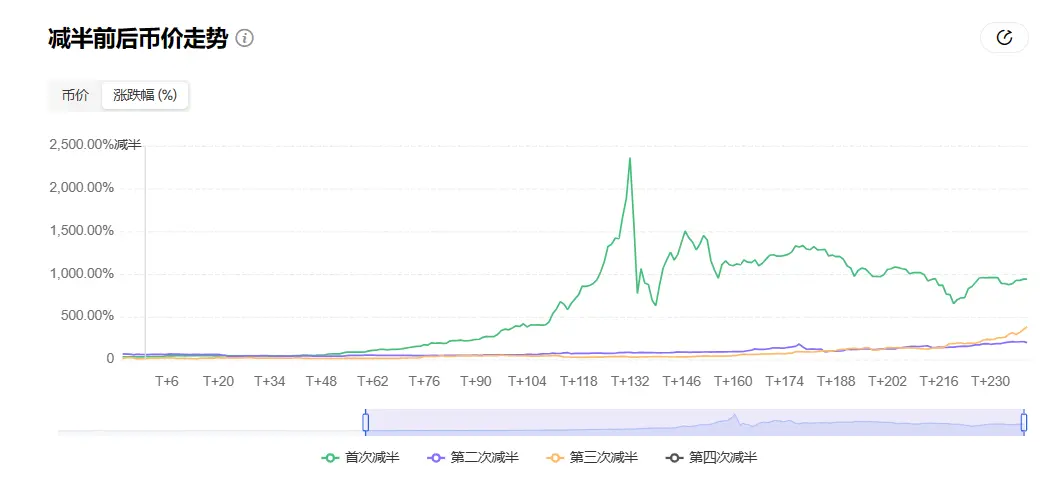
However, since the third halving in 2020, due to a significant increase in industry participants, market attention, and the improvement of supporting infrastructure, Bitcoin is no longer a niche product limited to geek circles, making it difficult to achieve several times the increase in scale. Therefore, compared to the halving points, it only increased by about 7 times.
To summarize simply:
- Before the first halving, insiders were more concerned about Bitcoin's potential as electronic cash;
- During the second halving cycle, the focus on Bitcoin shifted to its attributes as a payment tool, sparking a series of debates (the subsequent BCH fork was almost the top trend in the circle);
- In the third halving cycle, Bitcoin had already become an alternative asset, and the focus on traditional institutions and capital layouts began to dominate;
So, although the price fluctuations are not as significant as in the previous two halvings, the enthusiasm for Bitcoin's third halving was unprecedented. At the same time, the overall political and economic environment in the world during Bitcoin's third halving also influenced its performance:
Under the influence of macro factors, on March 12—13, two months before the halving on May 11, Bitcoin fell from $7,600, first fluctuating down to $5,500. Subsequently, it broke through support levels, dipping as low as $3,600, with the overall market cap evaporating by $55 billion, and over 20 billion RMB in liquidations across the network, accurately achieving "price halving."
However, after the halving in May, the DeFi summer initiated a new bull market cycle, with Bitcoin soaring to $60,000, nearly a 7-fold increase compared to the halving.

Overall, based on historical experience, within six months to a year after halving, BTC is highly likely to initiate a new bull market cycle. Although achieving more than a 10-fold increase may be difficult given the current size, surpassing the $100,000 or even $200,000 milestones is still quite promising.
New Variables Beyond Halving
However, at the same time, with Bitcoin having undergone three halvings, the block reward reduced to 6.25, and over 19 million Bitcoins mined, many situations and factors are now due for a fresh perspective.
Especially, the entire industry and Bitcoin itself have seen some noteworthy new variables compared to previous halvings.
Intensification of Mining Company Arms Race
As is well known, capital in the circle has always liked to collectively gamble on the "halving event." The continuously increasing hash rate, new hardware, and the upcoming reward halving will determine the overall growth of the industry and Bitcoin, and this is especially true now:
As of the latest Bitcoin mining difficulty adjustment at block height 836640—the mining difficulty reached 83.13T, nearly doubling compared to a year ago.
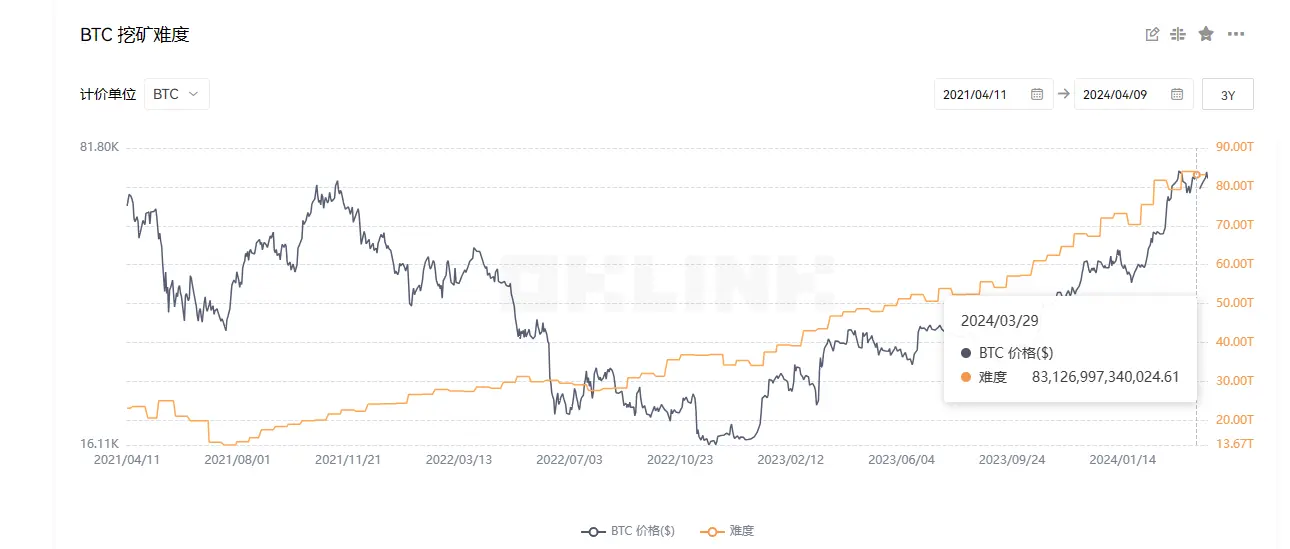
In this context, the hash rate of the entire network has skyrocketed by 100% over the past year, combined with the halving in 10 days that will sharply reduce the number of Bitcoins miners can mine by 50%. This means that miners must increase their hash rate investment to maintain stable operational cash flow and mine enough BTC to cover expenses.
This will further lead to a significant increase in network hash rate, necessitating an upward adjustment of mining difficulty to maintain a stable BTC production rate, thereby squeezing out higher-cost miners from the market.
According to a CoinShares research report, at the time of the halving in 10 days, the average production cost of Bitcoin for miners may rise significantly, with the median cost being over $42,000. However, due to the surge in Bitcoin prices over the past two months, the production costs for most miners are currently below market prices.
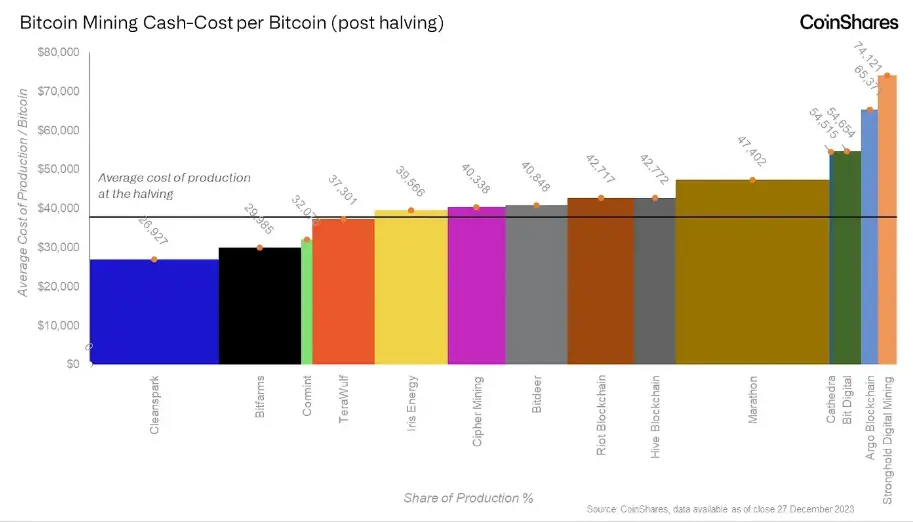
Therefore, it is not ruled out that this halving may present an exception, with the entire network's hash rate rapidly increasing at a steeper rate—since the first Bitcoin halving in 2012, as well as the subsequent halvings in 2016 and 2020, the hash rate typically decreases by about 9% after halving, a situation that usually lasts for about six months before recovering midway, followed by a surge in activity about a year before the next halving.
This cycle is logical: to remain competitive in anticipation of halving, miners increased capital expenditures, resulting in hash rates significantly above trend. After halving, miners' direct income decreases, affecting their capital expenditure cycles.
Miners are essentially in an arms race to purchase and increase as many machines as possible, and the variable of "market price > mining cost" will have to be continuously observed to see how it impacts the miner market and Bitcoin's secondary market.
Internal Evolution of the Bitcoin Ecosystem
According to Bitcoin's halving rules, the block reward started at 50 Bitcoins, halving every four years. It has already halved three times to 6.25, and this will continue until 2140 when there will be no more block rewards;
However, transaction fees will always exist, so with each round of halving, the block rewards will gradually decrease to nearly zero, and in the future, miners' income will become very singular, relying solely on transaction fee rewards.
Since 2023, the Bitcoin ecosystem, especially the prosperity of BRC20, has sparked a new wave of "BitcoinFi," with internal trading activity in the Bitcoin ecosystem reaching new peaks, thereby boosting Bitcoin's transaction fee income—currently, the total market cap of just the three new assets, ORDI, SATS, and RATS, is nearly $3 billion, with over 90,000 total holding addresses.
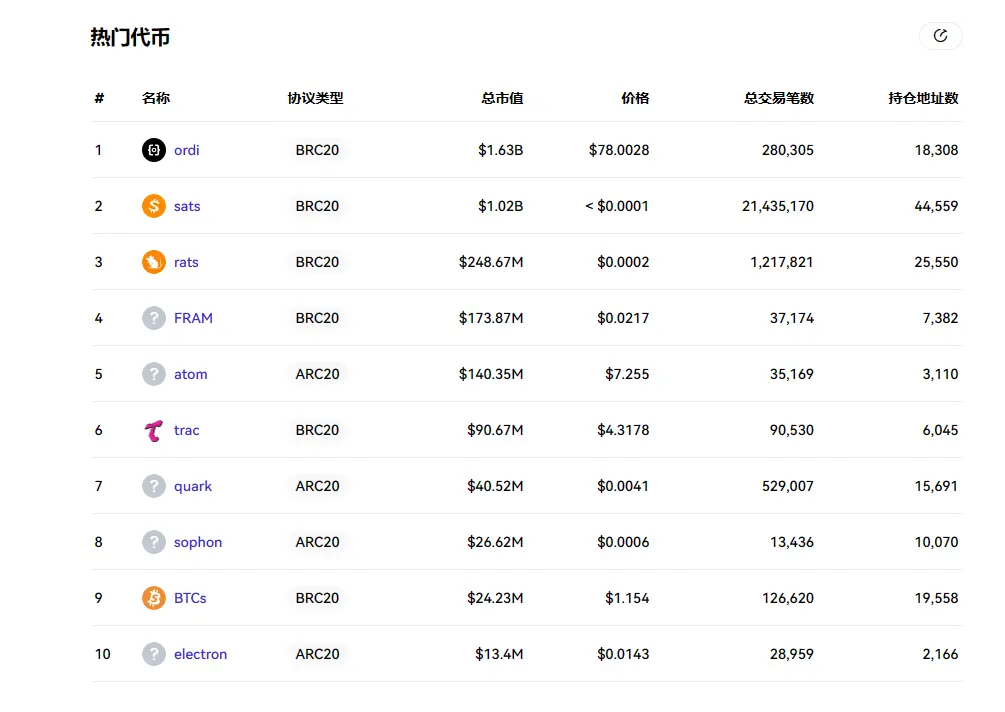
This wave of Ordinals has brought massive amounts of capital, users, and developers into the Bitcoin ecosystem through inscriptions: if previously Bitcoin only had advantages in "orthodox recognition" and total market cap, the inscription wave has significantly increased the richness of new assets in the Bitcoin ecosystem. The human demand for new assets is eternally present, and it has also indirectly increased the number of developers and user base.
In this context, protocol innovations like Ordinals, along with leading projects like ORDI and SATS, have profoundly impacted the fee model of the Bitcoin network—most directly, they have completely changed Bitcoin's economic and incentive models.
According to the latest data from OKLink, the proportion of Ordinals transactions on the Bitcoin chain has grown from 0% at the beginning of 2023 to now stabilize at over 50%.
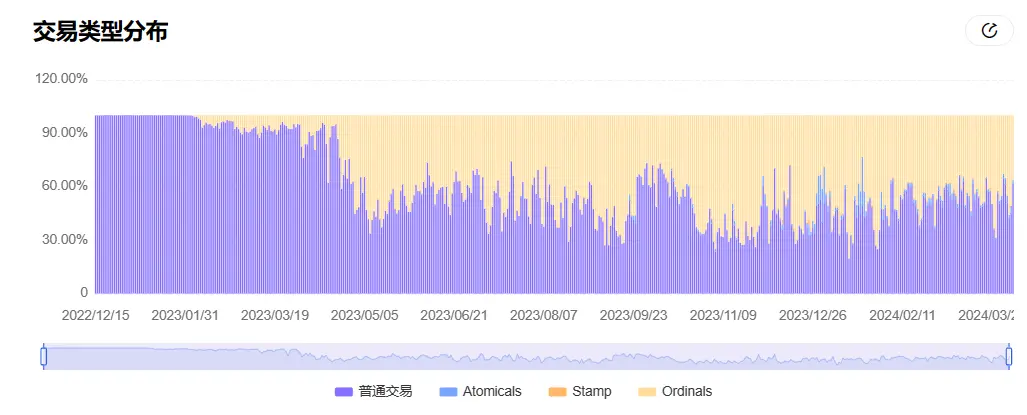
This has also propelled BTC mining fee revenues to a new high in nearly five years. Historically, miners' fee income has often only accounted for about 2%, and at the end of last year, it even reached as high as 40% (though it has receded somewhat in the last three months).
As subsequent block rewards gradually decrease to zero, the importance of transaction fees will only increase until they ultimately become the sole source of income.

Thus, this round of BRC20 can be seen as a prelude, and regardless of whether it succeeds, the variables accompanying the upcoming Bitcoin halving will undoubtedly profoundly change Bitcoin's overall fee model.
Summary
Overall, we are now at the tail end of a new halving cycle, which may be the first (or second) time for most participants and investors in this round to personally witness and experience the "grand event" of Bitcoin halving.
Everything that has happened is merely a prologue. As one of the most important narratives in the crypto industry, "Bitcoin halving" has always been a good medicine to boost market confidence. Now, as the bull's footsteps seem near yet distant, how Bitcoin and this cycle will proceed after the halving remains an unknown.



